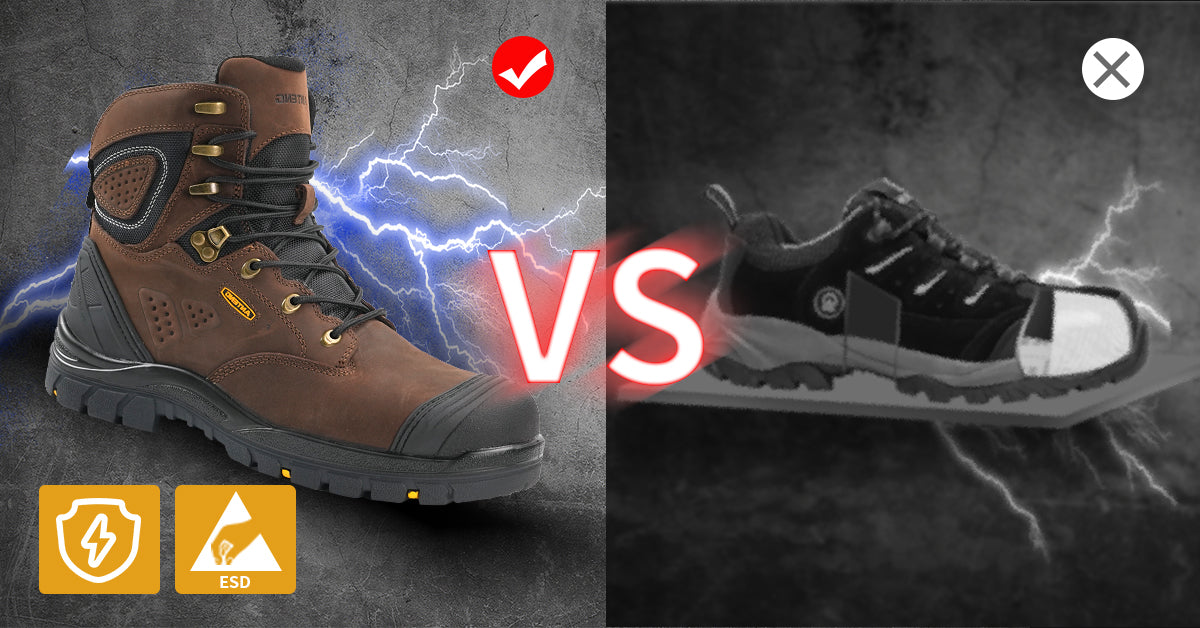
The Difference Between Regular Work Boots and ESD Work Boots
The Difference Between Regular Work Boots and ESD Work Boots
When choosing the right work boots, it is important to understand the difference between regular work boots and ESD (electrostatic discharge) work boots, as each type of shoe provides unique protection in different environments. Specific health and safety standards mandate the use of appropriate work boots in various industries, emphasizing the importance of selecting the right type for your safety needs.
Materials Used in Work Boots
Regular and ESD Work Boot Materials: Both regular and ESD work boots can be made from a variety of materials, each chosen for its specific properties that impact functionality and durability.
- Leather: A common material in both types of boots, leather provides durability, breathability, and water resistance, making it suitable for environments with physical hazards.
- Synthetic Materials: Materials such as nylon and polyurethane are often used for their lightweight properties, flexibility, and cost-effectiveness. ESD boots may use specialized synthetic materials to enhance static dissipation.
- Outsoles: The outsole material differs depending on the type of boot. Regular work boots typically use rubber or thermoplastic polyurethane (TPU) for slip resistance and durability, while ESD boots use conductive or dissipative compounds to safely discharge static electricity.
Functional Difference
Regular Work Boots: The main purpose of regular work boots is to protect the wearer from physical injuries. These boots are usually equipped with a protective toe cap made of steel or composite materials, and their design focuses on preventing impacts from falling objects on the feet. In addition, regular work boots also feature non-slip soles and puncture-proof midsoles. These features make regular work boots suitable for environments with physical safety risks, such as construction, industry, and warehousing. Regular work boots need to comply with relevant physical safety standards, such as EN ISO.
ESD Work Boots: The main function of ESD work boots is to prevent the accumulation of static electricity and release it safely to the ground, thereby reducing the risk of electrostatic damage to sensitive electronic equipment. Although ESD work boots also have basic foot protection functions, their primary design focus is on the safe dissipation of static electricity rather than protection against physical damage. ESD work boots need to comply with antistatic standards, such as CE or ASTM. Therefore, ESD work boots are suitable for static-sensitive environments, such as electronics manufacturing, semiconductor production, and laboratories.
Simply put, ESD work boots can serve as regular work boots, but regular work boots cannot be used as ESD work boots.
Use Scenarios
Regular Work Boots: Mainly suitable for workplaces that require physical protection, such as construction sites, heavy industrial production, and warehouses. In these environments, employees may face risks such as falling heavy objects, sharp objects, and slippery floors, which necessitate stronger physical protection.
- Case Study Example: A construction site in downtown New York requires workers to wear regular work boots to protect against potential falling debris and sharp materials. The site supervisor ensures all workers are equipped with steel-toe boots for maximum safety.
ESD Work Boots: Suitable for workplaces sensitive to static electricity, such as electronic component manufacturing, laboratories, semiconductor production, and environments with flammable materials. These workplaces need to reduce the risk of static electricity accumulation to prevent damage to sensitive equipment or fire hazards.
- Case Study Example: An electronics manufacturing facility in Silicon Valley mandates the use of ESD work boots to protect sensitive electronic components from electrostatic discharge. Employees working on circuit board assembly lines are required to wear ESD boots to minimize the risk of damage to expensive components.
Maintenance Tips
Regular Work Boots: To ensure regular work boots remain effective and durable:
- Cleaning: Regularly clean the boots to remove dirt and debris, which can degrade the materials over time.
- Conditioning: Use leather conditioners if the boots are made of leather to maintain flexibility and prevent cracking.
- Inspection: Regularly inspect the boots for signs of wear and tear, especially the soles and protective toe caps, and replace them if necessary.
ESD Work Boots: To maintain the effectiveness of ESD work boots:
- Cleaning: Keep the boots clean to ensure their static dissipative properties are not compromised. Avoid using harsh chemicals that may affect conductivity.
- Testing: Periodically test the ESD properties to ensure the boots are still effectively dissipating static electricity. This can be done using an ESD tester.
- Storage: Store the boots in a dry environment to prevent moisture from affecting the static dissipation properties.
Comparison Table
| Feature | Regular Work Boots | ESD Work Boots |
|---|---|---|
| Primary Function | Physical injury protection | Prevention of static electricity buildup |
| Toe Cap | Steel or composite | Steel or composite |
| Electrical Protection | Not designed for static electricity protection | Designed to dissipate static electricity |
| Compliance Standards | EN ISO | CE or ASTM |
| Suitable Environments | Construction, industry, warehousing | Electronics manufacturing, laboratories, semiconductors |
| Can Replace Each Other | No | Can serve as regular work boots |
| Maintenance Requirements | Clean regularly, condition leather, inspect for damage | Clean regularly, test ESD properties, store in dry environment |
Summary
The difference between regular work boots and ESD work boots lies in their functional focus and applicable work environment. Regular work boots focus on protection against physical injuries and are suitable for high-risk industrial and construction environments. In contrast, ESD work boots focus on preventing electrostatic discharge and protecting sensitive electronic equipment. They are ideal for electrostatic-sensitive workplaces, such as electronics production and laboratories. When choosing work boots, it is crucial to decide which type of footwear to use based on the specific working environment and safety needs.
Choosing the right ESD work boots ensures personal and equipment safety in sensitive work environments. Please browse our range of top-rated ESD work boots to find the ideal fit for your needs and maintain a safe workspace. Click here to explore the YIZHONCO ESD collection and find the perfect pair.

